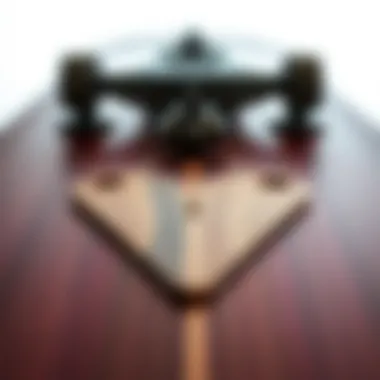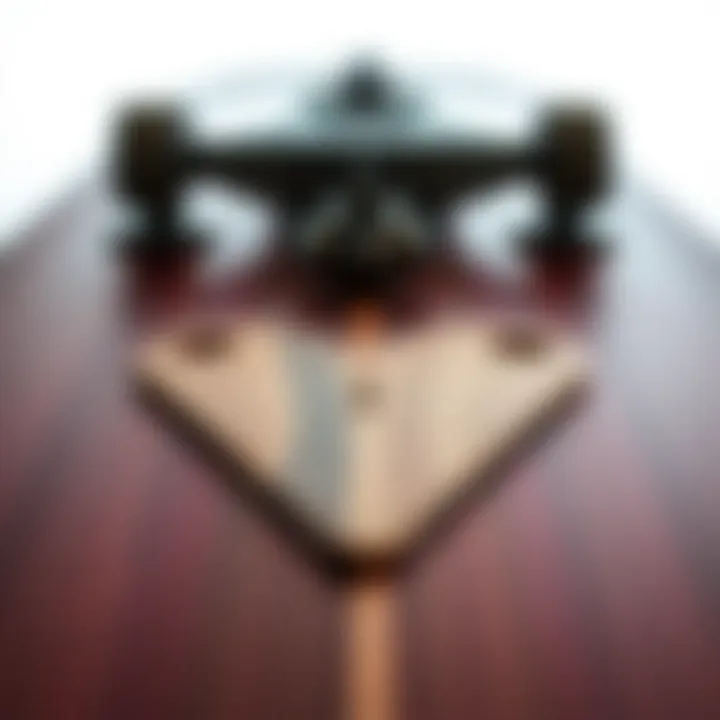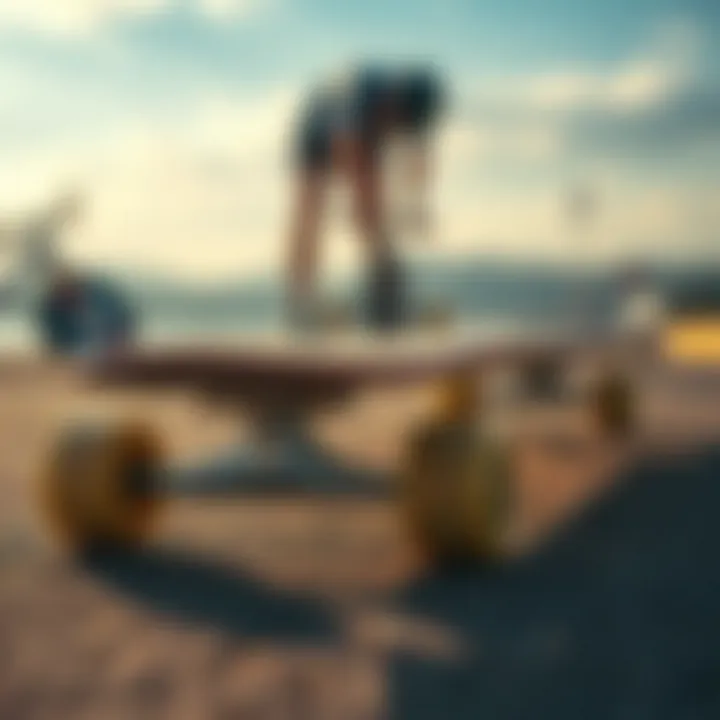In-Depth Look at Cruiser Longboard Decks and Their Features


Intro
Cruiser longboards have carved out a niche in the skateboarding world, attracting both newcomers and seasoned riders alike. They offer a smooth ride and an exhilarating experience, making them a favorite choice for those who enjoy leisurely gliding along city streets or navigating winding paths. The growing popularity stems from the unique combination of design, materials, and functionalities that these decks embody. This article will examine key factors that influence the choices of cruiser longboard decks, from their shapes and sizes to popular brands and the essential maintenance involved.
Understanding these elements is crucial for anyone involved in the skating community. Whether you’re a parent looking to equip your child with the right gear or a retailer trying to cater to the needs of your customers, grasping the nuances of cruiser longboards will deepen your understanding and enhance your experience in this dynamic sport.
In this exploration, we’ll analyze design principles, dive into material choices, and even touch upon the implications of deck shape and size. Not only will we dissect the options available, but we’ll also provide practical insights on how to care for these boards, ensuring they remain a valuable investment. For those with an eye for detail who crave comprehensive knowledge about cruiser longboard decks, this will be a worthwhile read.
Prolusion to Cruiser Longboard Decks
Navigating the world of cruiser longboard decks requires a substantial understanding of their design, materials, and overall purpose. Longboarding has surged in popularity over the years, capturing the attention of skateboard enthusiasts, both young and old. This article provides a thorough examination of cruiser longboard decks, dissecting essential elements that make them unique. With countless options available, recognizing the traits that matter most can make a world of difference for both beginners and seasoned riders alike.
Definition and Purpose
Cruiser longboard decks serve not just as a mode of transportation, but also as a platform for personal expression. Defined by their longer and wider structure compared to traditional skateboards, cruiser longboards are engineered for gentle rides and smoother navigation. Their primary purpose is to provide a comfortable, stable ride across various terrains, making them ideal for casual skating in parks or along coastal paths.
Many riders favor cruisers for their versatility; they can glide along smooth streets or tackle slight hills with ease. The smooth curves of the deck accommodate cruising styles that differ significantly from the aggressive maneuvers one might associate with more performance-oriented boards. There’s something refreshing about the leisurely approach to riding a cruiser, allowing skaters to enjoy the thrill without the firm pressure of tricks.
In essence, cruiser longboard decks appeal to a broad audience. From city slickers commuting to work to parents teaching their kids the ropes, the benefits they offer are manifold. Wider decks can support larger feet, while softer wheels make for a smoother experience over bumps and cracks.
The Evolution of Longboards
To truly grasp the significance of cruiser longboard decks, it’s worthwhile to consider their evolution. Longboards originally emerged as a fusion of surfing and skateboarding, intended to replicate the feel of riding waves on land. Over the decades, they have transformed from the rudimentary designs of the 1950s and 60s to the diverse range we see today.
Key milestones in longboard evolution include:
- The introduction of modern materials, like maple and bamboo, improved durability and responsiveness.
- Variations in shapes and sizes emerged to cater to different riding styles and preferences.
- Technological advancements in wheel and truck designs enhanced stability and grip.
Today, what was once a simple platform has matured into an intricate tapestry of styles and functions. Each design seeks to cater to a wide spectrum of riding experiences, while at the same time, preserving that thrilling essence that has captivated riders for generations.
"Longboarding is more than just a hobby; it’s an art form that evolves with every rider’s unique style."
Types of Cruiser Longboard Decks
Understanding the types of cruiser longboard decks is crucial for any rider looking to enhance their skating experience. Each deck type comes with its own unique attributes that can affect performance, style, and the overall ride. When selecting a longboard deck, it's vital to consider personal riding preferences, the intended use, and even the terrain where one plans to skate. Some deck shapes are better suited for cruising, while others thrive in diverse environments or for specific riding styles.
Standard Decks
Standard decks are the bread and butter of longboarding. These are typically symmetrical and give riders a balanced feel. They usually range from 32 to 40 inches in length and can be made from various woods like maple or bamboo, offering different levels of flexibility and stability. One of the main advantages of a standard deck is its versatility. Whether you’re casually cruising or trying to pick up some speed, these decks are up for the challenge.
Moreover, standard decks typically pair nicely with different truck setups, making them suitable for various riding styles. Skaters who appreciate a mix of comfort and performance often gravitate toward this type. However, it can be said that without a kicktail or special feature, the deck may not handle tricks as efficiently as others.
Drop-Through Decks
Drop-through decks provide a lower center of gravity, making them extremely stable and easier to push. This design entails that the trucks are mounted through the deck instead of the bottom. Because of this setup, the deck sits significantly closer to the ground, which is ideal for those who prefer a smooth and easy ride, especially on downhill paths.
One key benefit of drop-through decks is how they can greatly reduce fatigue on longer rides. The low stance means less force is required to maintain speed, making them perfect for cruising long distances while enjoying the scenery. However, skaters who enjoy more aggressive carvings might find that the flexibility of drop-throughs limits the ability to perform sharp turns.
Drop-Down Decks
Drop-down decks go a step further by offering an even lower center of gravity combined with a concave that keeps the rider locked in. The design resembles a drop-through setup but with a more pronounced shape, often tapering downwards in the middle. This characteristic allows for incredible stability when carving and maneuvering.
A significant advantage of drop-down decks involves their adaptability for riders who enjoy speed. The design allows for greater control on downhill runs. Moreover, the additional concave can aid in foot placement, providing skaters a more secure footing. However, riders should be mindful, as the lower stance could make it tricky to navigate uneven terrain.
Kicktail Decks
Kicktail decks are a short, versatile choice for riders who prefer a bit of flair and fun in their skating routine. They usually feature a pronounced upturn at the tail, allowing skaters to execute tricks like ollies and flips with ease. This design does not just cater to tricks; it also provides a way to maneuver quickly in tight spaces or to perform sharp turns.


Skaters who often skate in urban environments tend to favor these decks due to their agility. The kicktail grants the rider the ability to navigate obstacles and tight corners effortlessly. However, there's a catch: the kicktail may not always be the best choice for downhill riding, as stability could be sacrificed when pushing the limits at high speeds.
In summary, the type of cruiser longboard deck a rider chooses can significantly impact their experience. It's about finding the right fit for one's style and purposes. Before making a decision, it's advisable to think about where, how, and what you plan to ride. Each deck type brings its distinct advantages and challenges, and understanding these elements will aid anyone in making a more informed choice.
Key Factors in Choosing Longboard Decks
When it comes to selecting a longboard deck, a variety of crucial factors need to be considered. The deck serves as the central component of your ride, influencing not only the performance but also the overall riding experience. Understanding these key factors can mean the difference between a smooth cruise through the neighborhood and a bumpy ride that deters you from riding altogether. Elements like length, width, material, flexibility, and stiffness play pivotal roles in dictating how your board handles and how comfortable you feel while riding.
Length and Width Considerations
Length and width are fundamental aspects of any longboard. The dimensions of the deck impact its stability and maneuverability. A longer board tends to provide greater stability at high speeds, making it suitable for downhill rides. Conversely, shorter boards offer more agility and are better for tricks and tight turns. Most boards fall in the range of 28 to 40 inches in length. Width generally spans from 8 to 10 inches, affecting how much foot space you have.
- Stability: Longer decks offer more surface area and can help with balance.
- Control: Shorter boards lend themselves to easier pivoting and tricks.
It's about finding the balance that fits your riding style and comfort level.
Material Analysis
Wood
Wood is the classic material choice for longboards. It offers a natural feel and excellent responsiveness. Generally, maple is often used, lending durability and a touch of flex, which is great for absorbing bumps along the road. Wood's primary characteristic is its ability to provide a solid ride while being lightweight. One unique feature is the aesthetic appeal it brings to longboards; many riders appreciate the natural grain and custom patterns.
However, wood can suffer from water damage if not properly cared for, and its longevity varies with the type of wood used. It often proves to be a beneficial choice for those who value quality and craftsmanship in their longboarding experience.
Composite Materials
Composite materials are increasingly popular in the longboarding scene. Made typically from a blend of fiberglass and epoxy, these decks offer unique advantages: they are lightweight yet extremely strong. This type of construction allows for varied flex profiles, which can enhance performance especially in tricks and jumps.
One notable feature of composite materials is their resistance to the elements. They don’t warp or swell like wood might. However, the downside may include a higher price point, which can deter budget-minded riders from considering them as an option.
Plastic Decks
Plastic decks are gaining traction due to their affordability and versatility. These boards are typically highly durable and resistant to weather conditions, making them ideal for beginners who might not want to invest heavily at first. A major characteristic of plastic decks is their lightweight nature, which allows for easier transport—a handy feature for those who like to carry their boards around.
However, they can lack the same level of performance compared to wooden or composite boards, particularly in terms of ride feel and stability at high speeds. It’s a trade-off between price and performance that every rider needs to evaluate.
Flexibility and Stiffness
Flexibility is an often overlooked but critical factor in how a longboard behaves. A deck’s flex affects your ability to carve and perform tricks. Soft flex boards are forgiving and great for cruising, as they absorb bumps and provide a smoother ride. Stiff boards, on the other hand, offer more responsiveness, which is advantageous for high-speed rides and tricks. Riders must assess their style and preferences to determine what level of stiffness best suits their needs.
Ultimately, selecting a longboard deck goes beyond mere appearance. It calls for thoughtful assessment of length, width, material, and flexibility. Understanding these factors will set you up for a better riding journey, one that's tailored to your specific needs.
Understanding Deck Shape and Selection
The shape of a longboard deck fundamentally influences not just the aesthetics but also the way it rides. Selecting the right shape is paramount for enhancing performance and ensuring comfort for the rider. A well-structured deck can improve maneuverability, stability, and even the riding experience itself. By understanding deck shapes and their implications, riders can make more informed decisions tailored to their style and preferences in riding.
Concave Designs
Concave designs are integral to how a longboard responds to rider movements. There are several types of concave, including shallow, medium, and deep concaves. Each presents its own set of advantages. Shallow concaves may offer a more traditional feel, while deeper concaves provide increased foot traction, crucial during tight turns or aggressive maneuvers. Riders seeking to gain confidence while carving and quickly changing directions often favor the enhanced grip provided by a deeper concave.
Furthermore, the concave design can distribute rider weight across the deck more evenly, which can lead to a smoother ride in varied conditions. Those who frequently ride downhill may find a deep concave particularly beneficial, as it helps maintain control while speeding down slopes. In contrast, casual riders focusing on leisurely strolls may find that a flatter concave suits their needs better.
Tail Shape Variations
The tail of a longboard isn’t just a stylistic choice; it profoundly affects its functionality. Various tail shapes emerge in cruiser longboards, including square, rounded, and kicktail designs. Each shape serves a different purpose. For instance, a kicktail can enable pop, allowing for tricks and quick turns that are essential for urban skating. This is particularly useful when navigating city streets where obstacles crop up unexpectedly.
On the other hand, a square tail might add stability while allowing for better grip on the tail when performing tricks. Therefore, a rider’s style directly correlates with tail shape selection. A thoughtful approach to tail design can enhance turning capacity and precision in how the board is steered.


Nose and Tail Length Impact
Both the nose and tail length of a longboard can considerably influence riding dynamics. A longer tail can provide extended stability, crucial for maintaining balance during high-speed rides or carving. Conversely, a shorter tail can facilitate quicker repositioning during turns or tricks. This is beneficial for those who frequently ride in crowded environments or engage in technical riding.
Similarly, the nose length can impact how a rider approaches obstacles. A longer nose often allows riders to pop the board more easily off curbs or other features, thereby expanding the board’s utility for freestyle tricks. In contrast, shorter noses can provide a snug fit against the foot, enhancing turning responsiveness.
A longboard’s shape and selection go beyond surface impressions; it’s a reflection of riding style and personal preference that can boost both enjoyment and performance.
In summary, understanding the nuances of deck shape and the implications of different designs plays a pivotal role in enhancing the longboarding experience. Thus, exploring various concave designs, tail shapes, and nose lengths should be an integral part of the selection process for anyone serious about their longboard riding.
Popular Brands and Models
The section on popular brands and models serves a crucial role in understanding cruiser longboard decks. Choosing the right longboard can make or break the experience for skaters of all skill levels. There's a wide array of brands, each with their unique characteristics, designs, and features. Knowing the specific elements that each brand offers, such as durability, flex, and customization options, allows riders to select the board that best fits their riding style and preferences.
When it comes to longboards, brand reputation can greatly influence the quality of the deck. Some brands have become household names in the longboarding community, known for their innovation and craftsmanship. Riders looking to invest time and money into a cruiser longboard should explore these trusted names. It helps ensure they are buying a product that aligns with their individual needs and enhances their overall riding experience.
Brand A Overview
Brand A stands as a titan in the longboard industry, uniting quality craftsmanship with innovative design. Founded in the early 2000’s, this brand rapidly gained traction amongst skateboard enthusiasts for its attention to detail and rider feedback during product development. Their cruiser longboards often showcase an intricate blend of functionality and style, all while accommodating a wide range of riding styles, from casual cruising to more dynamic carving.
Notably, Brand A’s decks are made from high-grade Canadian maple, which provides an optimal balance of flexibility and durability. Riders appreciate the smooth ride and stability this brand offers, especially on varied terrains. Their unique graphics also cater to a personal expression, a crucial aspect of skating culture.
Brand B Overview
Brand B approaches longboarding from an exciting angle, focusing on environmentally-friendly materials and processes. This commitment to sustainability resonates widely with eco-conscious riders. Founded through a collaboration of passionate skaters, Brand B specializes in decks crafted from recycled materials and sustainably sourced wood. This means riders don’t compromise quality for environmental responsibility.
Riders commend Brand B for its lightweight decks, which enhance maneuverability without causing fatigue during prolonged rides. These boards come in various designs, ensuring there’s something for everyone. Adding to this, the brand often includes customizable options that enable riders to select deck dimensions and graphics tailored to their tastes.
Brand Overview
Brand C is often labelled as a pioneer in the longboard scene, particularly renowned for its focus on performance-oriented designs. This brand tends to cater more towards advanced riders, manufacturing decks that excel in technical riding styles. Founded out of a passion for downhill racing, Brand C emphasizes speed and stability without sacrificing comfort.
The standout features of Brand C decks are their unique drop-through designs that lower the rider's center of gravity, promoting enhanced stability at high speeds. Furthermore, this brand meticulously tests its prototypes on the steepest hills to ensure performance under real-world conditions. Riders interested in challenging rides find Brand C’s offerings compelling, as they provide high-speed capabilities alongside reliability.
"Choosing a longboard isn't just about the looks; it’s about the fusion of performance, comfort, and personal style."
In summary, exploring various brands and their offerings is essential for finding the right cruiser longboard deck. Each brand brings its unique strengths and design philosophies, shaping the experience of riders everywhere. By understanding what these brands represent, skaters can make more informed decisions that align with their personal journey in the world of longboarding.
Riding Techniques and Styles on Cruiser Longboards
Understanding riding techniques and styles is pivotal in the longboarding experience. These techniques not only impact your ability to maneuver and maintain balance but also deeply influence the overall enjoyment you derive from your time on the board. Different riding styles cater to diverse riding environments and personal preferences, allowing skateboarders to express themselves through their riding. Moreover, mastering various techniques enhances your control and confidence, especially as you encounter different terrains.
Basic Riding Techniques
Before embarking on your longboard journey, it's crucial to familiarize yourself with the basic riding techniques. Firstly, the stance is essential. Most riders will find themselves adopting either a regular stance (left foot forward) or a goofy stance (right foot forward). Finding your natural stance is key, as it directly affects your balance and comfort.
Once you've sorted your stance, practice how to push yourself off. A common approach is to keep your back foot on the tail while using your front foot to propel you forward. When it comes to balance, bend your knees slightly, and keep your torso aligned with your board. Engage your core to maintain stability at higher speeds.
Another fundamental technique is speed checks. Learning to slow down is just as important as accelerating—instead of relying solely on foot braking, which might be intimidating for some, try the heel drag technique. Placing your back foot heel gently onto the ground allows for effective speed control without compromising your balance.
Cruising vs. Carving
Cruising and carving are often seen as two sides of the same coin, yet they represent different approaches to riding. Cruising is about gliding smoothly along the streets or pathways. It’s often characterized by a relaxed foot position and less aggressive movements, benefitting riders who seek a more laid-back experience. This style is perfect for those navigating urban spaces or simply enjoying a leisurely ride. You often see riders who simply want to get from point A to B engage in cruising.
On the other hand, carving involves sharper turns and a more dynamic footwork approach. Riders subtly shift their weight from one side to the other, allowing for tighter turns that resemble the movements of a surfer. This technique not only helps in maneuvering through winding paths but also contributes to building speed. It can be exhilarating, as you learn to harness the board's natural flex to create smooth arcs while navigating at higher speeds.
Advanced Maneuvers


Once you’ve mastered the basics and have comfortably cruised and carved, you may want to explore more advanced maneuvers. Tricks such as slides, grinds, and 180s can vastly elevate your riding skills.
Slides allow for controlled skids, which facilitate speed reduction gracefully. The most typical technique is the Coleman Slide, where you lean back and shift your weight onto your back foot while guiding the board sideways. A sharp slide not only serves as a flashy way to slow down but also helps develop better board control.
Next, grinds refer to riding along a raised surface, principally curbs or railings. This requires a different setup; minimal and durable trucks are optimal to withstand the friction of grinding.
Lastly, 180s (or half-turns) add flair and help rev up your versatility on the board. They involve pivoting your body and the board in a half-circle motion, which is beneficial for quickly changing direction and adapting to new environments.
Mastering these techniques might take time, but the resulting skill set allows for an elevated longboarding experience. As you adapt and explore various combined techniques of cruising, carving, and flashy tricks, your confidence will invariably grow, alongside a deeper appreciation of your cruiser longboard.
"Every board has its own unique feel – getting to know those feels is what makes longboarding an art form."
For further reading and insights on riding styles and techniques, you may visit Wikipedia or engage with communities on Reddit.
By honing your riding techniques, you not only improve your skills but also enrich your overall experience on the board, ensuring each ride is as exhilarating as the last.
Maintenance and Care for Cruiser Longboards
Keeping your cruiser longboard in top shape is not just about aesthetics; it’s fundamental for safety and performance. Longboards endure a fair bit of wear and tear from daily rides, so regular maintenance is key to extending their lifespan. Whether you are a rider at the local park or commuting through the city, knowing how to care for your gear can make a world of difference.
Some benefits of maintaining your longboard include improved ride quality, reduced risk of accidents, and enhanced durability. For many skaters, spending a little time on maintenance is well worth it, ensuring that they get the most out of their rides. Let’s break down the essential elements of keeping your cruiser longboard in tip-top shape.
Cleaning Your Deck
Regular cleaning is probably the simplest yet often overlooked aspect of longboard care. Debris, dirt, and grime can accumulate on your deck over time, affecting grip and performance. Here’s how to keep your deck spick-and-span:
- Choose the Right Cleaner: Use a mild soap or specialized longboard cleaner to avoid damaging the graphics or grip tape.
- Gentle Scrubbing: A soft cloth or sponge works best. Just scrub gently to lift off dirt without causing scratches.
- Rinse with Care: After cleaning, thoroughly rinse off any soap residue. This step ensures no slippery film is left, which might pose a risk during rides.
- Dry Properly: Allow your deck to air dry completely before use, as moisture can lead to grip tape peeling or wood damage from prolonged exposure.
In essence, keeping your deck clean means a safer and more enjoyable riding experience.
Wheel and Bearing Upkeep
Wheels and bearings are critical components that often need your attention. Neglecting them can lead to performance issues and a less smooth ride. Here are some practical tips:
- Regular Inspection: Check for any cracks or flat spots on the wheels. If you find them, it may be time for a replacement.
- Keeping it Smooth: Clean your bearings regularly. Lint and grime build up can hinder the spinning. To clean, take them out and soak in a low-viscosity lubricant or a commercial bearing cleaner. Rinse thoroughly and let them dry before putting them back.
"Regularly maintaining your wheels and bearings can make the difference between a smooth ride and a jarring experience."
Lastly, replacing the bearings every once in a while will ensure you get consistent speed and performance during your rides.
Regular Inspections
In addition to cleaning and upkeep tasks, performing regular inspections is vital for overall maintenance. Here’s what to look out for:
- Hardware Tightness: Check the trucks, screws, and bolts to ensure everything is secure. Loose hardware can lead to accidents or even a deck falling apart mid-ride.
- Deck Integrity: Regularly examine the underside of your board for cracks or delamination, especially if you ride frequently or hit hard spots.
- Grip Tape Condition: Look for worn-down areas. If the grip tape is losing its texture, it can affect your stability while riding. Replacing it will give you better grip and confidence on your board.
By making regular inspections a part of your routine, you can catch potential issues before they become significant problems, ultimately extending the life of your cruiser longboard. Keeping your ride in shape not only enhances its look but ensures a smoother, safer skating experience.
The End: The Enduring Appeal of Cruiser Longboard Decks
As we wrap up our exploration of cruiser longboard decks, it’s apparent that they hold significant allure among skateboarders and casual riders alike. These decks are not just mere planks of wood; they embody a culture and lifestyle that resonates with freedom and adventure. Their versatile design caters to a variety of riding styles, making them a practical choice for many.
Summary of Key Points
To revisit the main ideas:
- Design Variety: Cruiser longboard decks come in many shapes and sizes, each tailored for specific riding styles. From kicktails for tricks to drop-through decks for easy learning, there's something for everyone.
- Material Differences: The choice of material dramatically affects the performance and feel of the board. Each material, be it wood, composite, or plastic, imparts unique characteristics that influence stability, flex, and durability.
- Riding Styles: Whether you're cruising along the beach or navigating a busy urban landscape, understanding the techniques for each riding style optimizes the experience. Balance and control come from practice and knowing how your deck functions underfoot.
- Maintenance Matters: Keeping your deck well-maintained not only prolongs its life but also ensures a smoother ride. Regularly checking wheels and bearings can save you from future hassles.
Future Trends in Longboard Design
The future of longboard design looks bright and innovative. As technology advances and more skaters prioritize eco-friendliness, we might see:
- Sustainable Materials: The demand for environmentally friendly options is growing. Expect to see more boards made from recycled materials or sustainably sourced woods.
- Integrated Technology: Some brands are toying with the idea of smart boards that track speed and distance. It’s a fascinating leap that could transform how riders interact with their boards.
- Enhanced Customization: With the rise of personalization in various markets, longboards might soon offer customization options like adjustable flex or interchangeable parts. This could cater to varying rider needs and preferences.
- Performance-oriented Designs: As riding styles evolve, deck designs may continually adapt to meet the demands of tricks or long-distance cruising, pushing the boundaries of performance.
The world of longboarding is ceaselessly evolving, and staying alert to these developments can enrich the riding experience.















